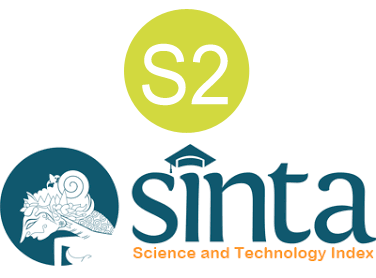Implikasi Ajaran Yoga Bagi Pamangku di Bali dalam Aspek Tri Sarira
DOI:
https://doi.org/10.37329/jpah.v7i3.2390Keywords:
Implications, Yoga Teachings for Pamangku, Tri SariraAbstract
The Patanjali Sutra Yoga teachings are not only gestures but also give the mandate to the existence of body and mind. A priest at the time of nganteb upakara was likened to a "mayoga" (in Balinese) that is, carrying out parts of the yoga teachings. The body is not only a construction of skeletal bones, muscles, flesh, and organs themselves. But the body can be seen and interpreted from several points of view. In Hinduism, there are three layers of the human body called Tri Sarira, namely sthula sarira, suksma sarira, and antahkarana sarira. The purpose of this article is to find out the implications of yoga teachings for the priest in the aspect of Tri Sarira. This research uses a qualitative approach with an interpretive paradigm. The results of this study show that the yoga teachings for the priest in Bali meaningfully have implications for physical and psychological influences on three layers of the body called Tri Sarira, namely sthula sarira (rough body), suksma sarira (subtle body), and antah karana sarira (causative body). The yogic teachings practiced by religious leader on sthula sarira (rough body) have implications on the body such as an upright sitting posture. Therefore, getting into the habit of taking a comfortable sitting posture upright for the priest will reduce symptoms and improve the bending of the spine. The yoga teachings practiced by the priest on suksma sarira (subtle body) have implications for inner satisfaction for the priest for being able to help others. The yoga teachings practiced by the priest in the middle of nowhere karana sarira (causal body) have implications for increasing awareness of the quality of life as a human being because it is an obligation to always be ethical and do good in serving the people. So, it can be concluded that the teachings of yoga have implications for the activities of the priest.
References
Acarya, A. A. (2001). Yoga Untuk Kesehatan. Jakarta: Persatuan Ananda Marga Indonesia.
Acharya, A. A. (2002). Meditasi Melampaui Batas Kesadaran Supra. Jakarta: Persatuan Ananda Marga Indonesia.
Adiputra, G. R. (2003). Pengetahuan Dasar Agama Hindu. Jakarta: PT Pustaka Mitra Jaya.
Anandamurti, S. S. (2009) Psikologi Yoga. Jakarta: Ananda Marga Indonesia.
Atmaja, N. B. (2014). Saraswati dan Ganesha sebagai symbol Paradigma Interpretativisme dan Positivisme : Visi Integral Mewujudkan Iptek dari Pembawa Musibah Menjadi Berkah Bagi Umat Manusia. Denpasar: Pustaka Larasan bekerja sama dengan IBIKK BCC Undiksa Singaraja.
Atmaja, N. B. (2015). (Ngaben+Memukur) = (Tubuh+Api) + Uparengga + Mantra) = (Dewa Pitara + Surga). Denpasar: Pustaka Larasan bekerja sama dengan IBIKK BCCC Undiksa Singaraja.
Cudamani. (1987). Pengantar Agama Hindu Untuk Perguruan Tinggi. Jakarta: Yayasan Wisma Jakarta.
Cudamani. (1999). Mengatasi Stres Menurut Pandangan Agama Hindu. Surabaya: Paramita.
Dewi, P. A. S. K., & Puasa, I. M. G. (2020). Komunikasi Transendental dalam Yoga. Jurnal Yoga Dan Kesehatan, 3(2), 108-115.
Donder, I. K. (2007). Kosmologi Hindu. Surabaya: Paramita.
Krishna, A. (2015). Yoga Sutra Patanjali Bagi Orang Modern. Jakarta: PT Gramedia Pustaka Utama.
Nala, N. (1992). Kumpulan Tulisan Olahraga. Denpasar: KONI Bali
Nala, N. (2002). Usada Bali. Denpasar: Upadasastra.
Nerta, I. W. (2021). Implementasi Ajaran Yoga Kapamangkuan Di Pasraman Mulat Sarira Desa Adat Duda Desa Duda Timur Kecamatan Selat Kabupaten Karangasem. Jurnal Penelitian Agama Hindu, 5(3), 188-199.
Maswinara, I W. (2000) Kedamaian di Tengah Prahara. Surabaya: Paramita
Parisada Hindu Dharma Indonesia Pusat (1988) Himpunan keputusan Seminar Kesatuan Tafsir Terhadap Aspek-aspek Agama Hindu, I-XIV. Denpasar: PHDI Pusat.
Polak, M. (1979). Patanjali Raja Yoga. Surabaya: Paramita
Poniman, R. (2020). Pentingnya Laku Semedi Bagi Pemangku dan Pinandhita. Jurnal Yoga dan Kesehatan, 3(1), 38-55.
Pudja, G. M. (1986). Sraddha. Jakarta: Mayasari
Putra, I. G. A. G & Sadia, I W. (1988). Wrspati Tattwa. Jakarta: Yayasan Dharma Sarathi.
Punyatmadja, I. B. (1992). Panca Srada. Jakarta: Yayasan Dharma Sarathi.
Saraswati, S. S. (1996). Patanjali Raja Yoga, Alih Bahasa Mayor Polak. Surabaya: Paramita.
Saraswati, S. S. (2002). Asana, Pranayama, Mudra Bandha. Surabaya: Paramita.
Simatupang, L. (2013). Pergelaran sebuah Muzaik Penelitian Seni-Budaya. Jogyakarta: Jalasutra.
Subawa, I. M. P., & Junianti, P. S. (2020). Sasana Kapamangkuan: Sebuah Ajaran Tattwa dan Etika dalam Membangun Kesadaran Diri Sebagai Pelayan Umat. Sphatika: Jurnal Teologi, 11(1), 42-57.
Sugata, I. M., & Juniartha, M. G. (2022). Implementasi Ajaran Hatha Yoga Pada Gheraṇḍa Saṁhitā Dalam Kehidupan Praktis. Jurnal Penelitian Agama Hindu, 6(4), 255-271.
Suhardana, D. K. (2006). Pengantar Beberatan Pamangku. Surabaya: Paramita.
Suhardana, D. K. (2010). Kusuma Dewa, Lima Versi Persamaan dan Perbedaan. Surabaya: Paramita.
Sumertini, N. W. (2021). Filsafat Manusia dalam Bhagavad Gita. Sanjiwani: Jurnal Filsafat, 12(1), 42-54.
Downloads
Published
How to Cite
Issue
Section
License
Copyright (c) 2023 I Wayan Nerta

This work is licensed under a Creative Commons Attribution-ShareAlike 4.0 International License.
An author who publishes in the Jurnal Penelitian Agama Hindu agrees to the following terms:
- Author retains the copyright and grants the journal the right of first publication of the work simultaneously licensed under the Creative Commons Attribution-ShareAlike 4.0 License that allows others to share the work with an acknowledgement of the work's authorship and initial publication in this journal
- Author is able to enter into separate, additional contractual arrangements for the non-exclusive distribution of the journal's published version of the work (e.g., post it to an institutional repository or publish it in a book) with the acknowledgement of its initial publication in this journal.
- Author is permitted and encouraged to post his/her work online (e.g., in institutional repositories or on their website) prior to and during the submission process, as it can lead to productive exchanges, as well as earlier and greater citation of the published work (See The Effect of Open Access).
Read more about the Creative Commons Attribution-ShareAlike 4.0 Licence here: https://creativecommons.org/licenses/by-sa/4.0/.








